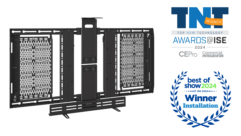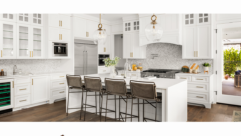Eatery Goes Retro With AV
The new sound and video systems at Jackie’s restaurant help entertain patrons inside and out.
CHALLENGE: Design a cost-effective AV system to complement the ambience of a 60s-themed restaurant in an inhospitable acoustical environment.
SOLUTION: Create an AV design that blends commercial audio components and equalization with a unique projection system and a two-sided screen.
A ONE-TIME warehouse and garage built in the 1920s, Jackie’s restaurant is the latest creative expression of real estate developer Jackie Greenbaum and ex-husband/restaurateur Patrick Higgins. Retaining the original facility’s bare brick walls, high ceiling, and exposed ductwork, the 60s-themed restaurant houses a bar, a lounge, and a main dining area below street level. In the dining room, an “exhibition” kitchen spans the rear wall to offer diners a full view of food preparations. A big part of the fun at Jackie’s is its AV experience, which adds color and artistic imagery to a transparent, double-sided screen that separates the bar from the dining area and can also be seen from the outside of the restaurant.
“Jackie is very much into music and art,” says Roly Jan, sales manager of Silver Spring, MD-based systems integration firm Total Audio Visual Systems, which implemented a versatile AV blueprint for the restaurant. “Quality music and AV is a vital part of the draw. Music cranks up the fun during dinner hours, then, after 10 p.m., it takes a turn toward nightclub levels, letting people get up and dance. AV is really part of the decor. It’s used to further the restaurant’s aura of ’60s coolness, and create other textures. This is a happening location, definitely not the kind of place where you’d find 30 video monitors tuned to sports stations.”
In accordance with Total Audio Visual Systems’ comprehensive AV plan, Jackie’s is divided into six dedicated audio zones: the bar, dining room, gallery, restroom/hallway areas, private dining room, and Greenbaum’s office. Served by source program material including computer-generated tunes as well as CDs, the zones were constructed with expansion in mind to accommodate a DJ and live music in the future.
Richard Shaeer, principal of Pikesville, MD-based Shaeer Media Solutions, Inter-M America’s independent sales rep for the region, worked with input from both Jan and Greenbaum to devise the audio design, which combines high-end sonic quality with simple control functions and commercial reliability. Taking a distributed approach to the project, Shaeer’s blueprint deployed 36 AMK Innovations coaxial, 8-inch SA 802/SA 872 ceiling speakers operating at 8 ohms within all six zones of the restaurant’s 1,800-square-foot space. Each SA 802/SA 872 speaker receives power from seven Inter-M L-800 two-channel amplifiers.
LOW IMPEDANCE VS. CONSTANT VOLTAGE
Low-Impedance (8-ohm to 16-ohm) Speakers:
Constant voltage systems are often specified when a single power amplifier drives many loudspeakers through long cable runs (distances of more than 50 feet). As with many design decisions, there are advantages and disadvantages:
- Low-impedance speakers have a direct connection from the power amplifier, resulting in more efficient transfer of power for short and medium cable runs. There is no input transformer on the speaker and the amplifiers don’t have output transformers, both of which can reduce the total power delivered to the speakers.
- Low-impedance speakers often provide higher headroom, both within the speaker and from the amplifier.
- Low-impedance speakers provide greater output level because they’re not limited by the power tap setting of a 70 V/100 V speaker.
70 V/100 V Speakers:
- Constant (high) voltage lines reduce power loss due to cable heating.
- 70 V/100 V speakers are a good choice if you’re using so many speakers that the impedance would be too low for a low-impedance amplifier to drive.
- 70 V/100 V speakers allow individual adjustment of the level of each speaker up or down (using the tap selector switch).
- 70 V/100 V speakers are often easier to configure into systems with complex zoning and level control requirements.
- 70 V/100 V lines can transfer power more effectively using considerably smaller gauge speaker cables, which can result in significant cost savings on longer cable runs.
- Be sure the speaker is equipped only with a high-quality transformer — saturation from inexpensive transformers or autoformers can cause unpleasant distortion at all levels and often prevent operating the speakers below 100 Hz.
While typical commercial sound systems operate multiple loudspeakers in a 70 V constant voltage system, Shaeer chose to run the speakers at 8 ohms in order to optimize sound quality (see sidebar). “Especially at low frequencies, you get better sound quality using an 8-ohm system because there is no transformer in the circuit,” he says.
An Inter-M PX-0288 8×8 matrix mixer manages matrix control within each zone, enabling local audio sources to be routed in any combination to up to eight zones using local or remote control. The PX-0288 can receive up to eight local music sources at a time, while local and remote paging capabilities are provided with priority override. Wall-mounted Inter-M PS-88 remote program selectors in each zone interface with the PX-0288 matrix control for quick access to any available source as well as priorities via an LED display.
“Ease-of-use is as important within this application as reliability,” Jan says. “Waiters and waitresses as well as the patrons in the private dining room need to have quick and easy control over the system. The PS-88 remotes from Inter-M provide an intuitive package that anyone can operate without much thought. From our perspective, they’re a plus because they’re quick to install, look good in each room, and aren’t budget-breakers when it comes to cost.”
To combat the poor acoustical effects presented by the harsh, reflective brick surfaces and high ceilings in the main dining area and gallery, equalization was introduced using Inter-M DSP-based, two-channel GEQ-2231 units. The GEQ-2231 devices deliver 31 bands of graphic EQ dedicated to each space individually, while additionally offering limiting, a 24-bit A/D converter, and 64 kHz sampling frequency. “These are raw reverberant spaces,” Jan says. “With the GEQ-2231s, however, we were able to tame each via DSP performance managed with analog-style controls, a feature which went a long way to promote our goal of keeping things simple to use.”
Because the house audio rig uses a high-density, distributed design run at low impedance, Shaeer felt it was imperative to provide equalization to optimize its fidelity. His approach was an iterative process involving critical listening to source material, adjusting equalization, and then listening again. While painstaking and time-consuming, the result was a virtually seamless audio environment throughout the restaurant.
“I included the GEQ units to both improve the general quality of sound and give us consistent coverage through the restaurant,” he says. “Because there are multiple speakers in each zone with overlapping coverage, I needed something that would allow us to correct some of the natural phasing and comb filtering that occurs in the low/mid frequencies. The GEQs provided that tool, and also let us optimally fine-tune the whole environment and then lockout our settings. Now, wherever you go, the sound is the same. There are no hotspots or places where you can’t hear.”
With its own sound reinforcement coming from the house audio system, video presentation at Jackie’s relies upon a Sony VPL-CX70 XGA-resolution projector that provides 2,000 ANSI lumens of brightness. The compact unit was hidden within the rafters of the bar area and aimed at a 10-foot-wide screen — similar to a theatrical scrim — separating the bar from the dining room. With source material coming from a laptop providing DVD playback as well as still images of art and photos, the projector displays images that can be seen in the bar and dining room as well as by people outside through the main front window, thanks to the transparency of the screen.
FOR MORE INFORMATION
AMK Innovations www.amkinnovations.com
Inter-M www.inter-m.net
Sony www.sony.com
“The video display can be a moving kaleidoscope of form and color, but it didn’t cost a lot,” Jan says. “The double-sided nature of the screen makes it accessible to far more people than a traditional design would. It definitely catches the eye, and lures people in from the sidewalk to see what’s going on.”
Commissioned late last year, the restaurant’s new audio and video systems, which came in at about $19,000, have been very successful. “The ambience jumps with energy and excitement,” Jan says. “There’s good food, great music, innovative AV, and an almost limitless room to expand on a systems level.”
Gregory DeTogne is a freelance writer based in Libertyville, IL. He can be reached at [email protected].










